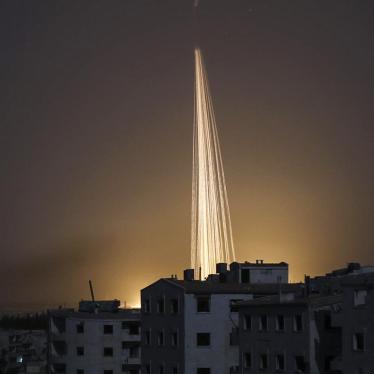Thank you, Mr. Chairperson.
The exceptional cruelty and ongoing use of incendiary weapons demand a global response.
Over the past year, Human Rights Watch has documented thirty new attacks with incendiary weapons across six governorates of Syria. While the use of such weapons is not new to that conflict, the number of attacks in 2018 is almost double the annual average for the previous five years.
One attack in eastern Ghouta in March 2018 exemplifies the extent of harm that incendiary weapons can cause. According to Syria Civil Defense, this strike killed at least 61 people and injured more than 200.
In light of these developments, Human Rights Watch welcomes the productive discussions of Protocol III that have taken place this week. Many states have expressed their outrage at the recent use of incendiary weapons and supported continuing discussions next year. In some cases, they have called for strengthening existing law. High Contracting Parties should act on these statements in order better to protect civilians.
Incendiary weapons inflict excruciating burns and require agonizing treatments. They cause respiratory damage and organ failure. People who survive initial injury often endure psychological trauma and severe disfigurement that can lead to being shunned by society.
Protocol III provides some protection from these effects, but as a number of states have mentioned, the protocol has two major loopholes that weaken its impact. First, its definition excludes multipurpose munitions, such as white phosphorus, that operate in the same manner and cause comparable harm as the incendiary weapons covered by the protocol. Second, the protocol’s regulations create an arbitrary and outdated distinction between the use of air- and ground-launched incendiary weapons.
Strengthening this law is a humanitarian imperative. It is also legally straightforward.
Small changes to the protocol’s text would close its loopholes. Article 1 should adopt an effects- rather than design-based definition of incendiary weapons in order to encompass multipurpose munitions with significant incendiary effects. Article 2 should prohibit the use of all incendiary weapons, regardless of their delivery system, in concentrations of civilians.
These simple changes could save lives by imposing stricter legal obligations and building the stigma against incendiary weapons, which can in turn influence the actions of parties outside the CCW.
States parties often refer to the CCW as a flexible, dynamic, and living document. Since 1980, states parties have amended one protocol, adopted two new ones, and expanded the scope of the framework convention. But they have yet to properly review Protocol III and to assess its adequacy for dealing with the concerns of contemporary armed conflict.
Momentum for addressing the problems caused by incendiary weapons has grown steadily, particularly since Protocol III was added to the agenda of the Meeting of High Contracting Parties last year. States should seize this opportunity to deepen discussions and move toward more concrete action.
We call on states to continue to condemn recent use of incendiary weapons. We urge them to dedicate additional time for discussion in 2019 to examine in more depth the adequacy of Protocol III and ways to address its shortcomings. They should then agree to a negotiating mandate with the goal of strengthening the protocol the following year.
For more information, please see our new report, “Myths and Realities about Incendiary Weapons,” and our overview of new developments over the past year.
Thank you.







